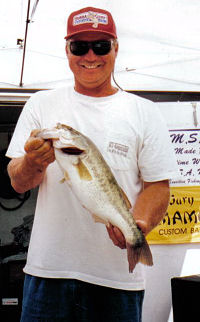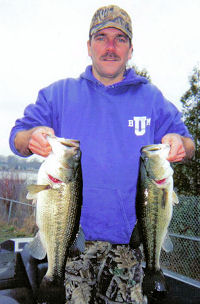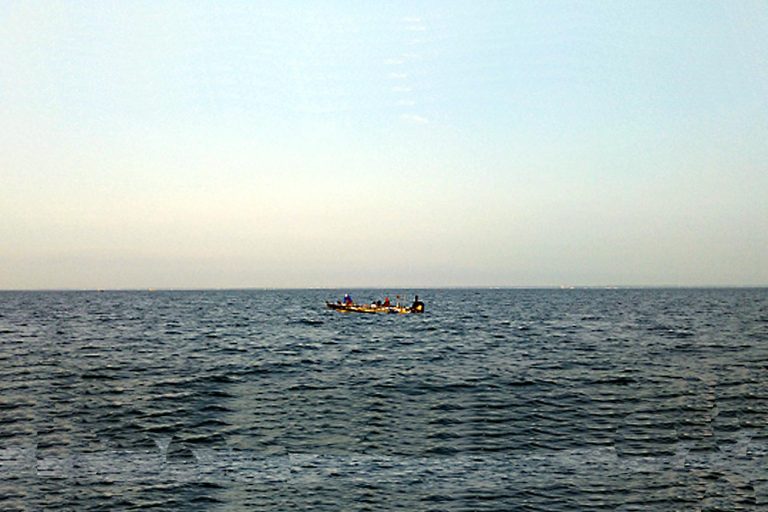The St. Joe River Comes to Life
“Everyone used to hate it,” is how Doug Roher explains the feelings fellow bass anglers had towards the St. Joe River. In recent times though, size, quality, and consequently, feelings have changed towards this one-time nemesis of Northern Indiana bass anglers. Roher knows the river like few others; he fishes it 50 times a year and now almost regrettably acknowledges his peers’ change in attitude. “Now everyone wants to be a river rat. I’m no longer the only one out there!”
Who can blame the change of heart though? The past two years has seen a remarkable change in catch ratios. And what better resource is there than that given to us by anglers who make bass their business? Mickey Thomas and Dave Clark are the two most prominent tournament directors in Northwest Indiana and Southwest Michigan. They run a weeknight division, Michiana Weeknight Tournament Series, that averages 31 teams per event every Tuesday and Thursday from late May to early August. They visit this stretch of the river several times each season. Their events enforce a 5 fish limit.
Mickey saw the improved fishing last year firsthand, “Overall, the creel limits were up by a large amount. On the weeknight circuit in 2005 we caught 622 fish that weighed 934.5 pounds on Tuesday’s and 575 fish weighing 882.75 pounds on Thursday’s. In comparison, this past season (2006), Tuesday night anglers caught a total of 842 fish weighing 1272 pounds and Thursday night caught 875 fish weighing 1244 pounds.”
Mickey and Dave also work with the Miller Brewing Company to run the largest fishing event in the area. They host this affair on the St. Joe River as well. In two events, which averaged 87 teams, 320 fish were weighed in. This is an incredible average of 3.7 fish per team. The increase in quality and quantity has changed the expectations amongst anglers, as Roher, a South Bend native, elaborates further, “A limit of 12 inch fish used to be a big deal, you would feel pretty proud with that. But now if you don’t have over 10 pounds in five fish, it’s not a big deal.”
Before the Miller event arrived in 2005, the biggest fishing event on the St. Joe River was the annual Mishawaka Firefighters Charity Bass Tournament. This event has raised thousands of dollars for children who are recovering from severe burns. The event often attracts many of the areas best river anglers and 2006 also saw an increase in fish quantity and quality. The director, Larry Regina, noted that in 2004 with forty-six teams participating, 158 fish were caught averaging 1.21# apiece. In comparison in 2006, with also forty-six teams, 199 fish were caught averaging 1.4# each. Regina also noted that in 2004 the biggest bass caught weighed 2.89# but in 2006 the biggest bass was a 5.69# giant. Regina, a firefighter himself, also noted, “In years past there was usually a 50/50 mix of largemouth and smallmouth, but last year the largemouth dominated the event. They were bigger and a lot more of them.”
The St. Joe River meanders 210 miles in Southern Michigan and Northern Indiana with the assistance of 10 dams before it deposits into Lake Michigan. Bass fishing can be good between any set of dams; however, it receives its most attention in the stretch between Mishawaka and Elkhart; often referred to as the “Maggie’s” stretch because of the large free public launch site, Margaret J. Pricket Park, located off Jefferson Boulevard in Mishawaka. This launch is located at the westernmost end of that stretch where little current exists. However, the farther east you travel into Elkhart County the stronger the current gets. This stretch also offers abundant weed growth, wood, seawalls, and rock, making the opportunities boundless for anglers.
So why has bass fishing improved so much? According to the Indiana District 2 fisheries biologist Neil Ledet, there is no way to draw conclusions. He states, “One or two years isn’t a lot of time to draw conclusions.” However, Northern Indiana bass icon Kevin Fletcher, who has been fishing the river for over thirty-five years, has his own theories, “There has been favorable spawning conditions the past several years whereas the preceding years were not optimal for spawning. We’re now seeing the benefits of this.” Fletcher doesn’t feel this is the only thing going well on the river either, “The shad population also appears to have exploded. The bass are eating better than ever before and they’re getting bigger.”

When discussing bass on the St. Joe River it’s important to recognize that both largemouth and smallmouth can be caught anywhere. And often you can catch both at the same location. With the bass becoming more plentiful and bigger, there is no better time to fish it. The following advice from Doug Roher and Kevin Fletcher will help you hook both largemouth and smallmouth bass this season on the Maggies stretch.
Spring
When winter finishes up its final assaults on Northern Indiana it’s a good idea to head out to the river opposed to a lake. “Water temperature rises in the river before they do in local lakes,” according to Roher, who has been fishing this stretch for 22 years. Fletcher, elaborates, “The darker bottom warms up faster than our clear natural lakes in the area. Also, bugs begin to hatch and bass begin roaming looking for a meal.” Both anglers acknowledge that the action first heats up in early April and stays hot until late October.
When fishing in the spring Fletcher suggests anglers, “Look for slower water. This water warms up faster and bass don’t need to exert as much energy as they do in the current.” He also adds that wood is more of a factor in the spring than any other time throughout the year. Fletcher suggests, “Look for spawning areas in the spring. The spawn determines everything this time of year. Before they spawn they’re searching for areas to spawn and eating simultaneously.” Structure, such as wood, in spawning areas can make a dynamic combination. Roher also advises anglers to be observant when fishing this time of year, “When you catch a fish, learn from it: notice exactly what you did when that fish bit and duplicate it; patterns can be hard to determine this time of year and subtle details can be critical at putting the puzzle together.”
Neither Roher nor Fletcher suggest going to the river with the intent of using just one or two baits. Roher warns, “Never go to the river relying one bait. My success derives from my ability to stay focused while on the water and making changes when necessary. These fish can be finicky and the bite can change multiple times in a given day. An angler needs to be ready for this.” Fletcher concurs stating, “Its not about baits on the river. The most important thing is being able to respond to conditions and adjust accordingly. That may require you to change baits, retrieve speed, or even locations.” With this in mind, they agree a good place to start when selecting springtime baits is with minnow baits such as jerkbaits, spinnerbaits, and crankbaits.
When the spawn comes into full swing, fish can be found around shallow objects and structure in the same areas. Fish often set up their beds with protection from the current so check the down current side of structure first. These fish will be fierce protectors of their eggs. Keep your eyes keyed on structure and what’s around them; you may come across a bed. Once locating an occupied bed, it’s generally best to put the horizontal baits such as crankbaits, down, and toss a vertical bait to the nest. Good choices include tube baits and plastic stick baits. Not all fish will bite immediately. Multiple casts might be necessary.
When the spawn concludes bass move out of shallow spawning grounds. They move to the nearest break that offers some protection on the main river channel. Fletcher, the Elkhart, IN resident, has success at this time by targeting the bass protecting their fry, “Fish begin to guard fry and move closer to main river channel areas that also provide some sort of structure for protection.” The protective males will attack objects and animals that try to prey on their fry. To catch these fish Roher applies a tactic he refers to as “Bust and Move.” Roher will target a large number of areas that fit this description and hit all of them with fast moving baits until he finds some fish. “If they don’t bite, move to another spot and switch baits. You have to adjust until you have some success. Once you have some bites, you can begin putting the puzzle together.”
Again both anglers warn against being stubborn with bait selection as both vertical and horizontal baits can be effective and the bite can change from day-to-day or even hour-to-hour and fish can also abandon areas that produced earlier.

Summer
According to Fletcher, who boasts 30 tournament wins on the river, when bass begin to abandon their fry, “The bite gets real good.” As fishing improves, the techniques also change Roher points out. “The patterns tend to relate more to minnows as it did during pre-spawn.” This is when bass begin to gorge on the shad previously mentioned. Consequently, anglers have success with a large number of baits and can establish a multitude of patterns sometimes concurrently.
Early in the day, topwater action can be phenomenal on the river. Buzzbaits and pop-r’s can produce violent strikes. As the day warms, crankbaits and spinnerbaits can be equally deadly. These baits are good choices because of the heavy feeding on shad.
Anglers should especially begin to pay close attention to the structure on the main river in summer. As during the spring, wood can often hold big largemouth bass. Crankbaits and spinnerbaits can coax these fish out, but it may be necessary to target these isolated pieces of structures with a vertical bait such as worms and jigs. This pattern can especially come into play during the dog days of summer when bass tend to be a bit more fickle and hold closer to structure.
Rock is another form of cover available for bass. As an angler heads farther east on the river they will encounter stronger current and come across more rock than the western half. This rock is a popular hangout for crawfish. Consequently, tube baits and jigs are effective bait choices. However, rocks on the river can also serve as eddies. Therefore, baitfish will also hold here. Minnow-type baits can produce strikes too.
Fall
Roher and Fletcher learn a great deal about the bass throughout a season. When fall rolls around they take the knowledge they’ve gained and apply it. Roher, who boasts 20 tournament wins on the river, admits, “I don’t change a thing in the fall from the summer months. The same techniques, baits, and places will work now as the summer.” Fletcher confirms, “There’s not much of a need to change until late fall; as with summer, a number of things can work.”
Another form of structure that can be productive in the fall as well as summer are the numerous seawalls found on the river. Seawalls can have shallow or deep water in front of them. They also come in a variety of materials and shapes. Both shallow and deep seawalls can produce, but the deeper seawalls tend to produce more consistently, especially with smallmouth. The depth will hold fish throughout a day whereas a shallow seawall may only produce in low-light conditions or heavy feeding times. The seawalls that hold some additional structure such as wood or rock are especially attractive. As with all structure on the river, bait selection tends to be a trial and error deal. At times, vertical baits are the ticket while other times require horizontal baits.
While seawalls and wood are consistent producers on the river, anglers should also familiarize themselves with the many weedbeds that exist. 2006 saw an explosion of weeds on the river and many anglers feel that this is partly responsible for the increase in fish productivity. Thick mats form in several areas and can be worked with weedless baits such as floating frogs and Texas-rigged worms or creature baits. Shad will also seek cover around weeds thus spinnerbaits and crankbaits fished around the edges can be productive. Bass will move in and out of the weeds throughout the day. Thus, it can be best to begin by throwing buzzbaits around the outside edge early in the day and then work weedless baits as the sun rises and the activity lessens.
Take Caution
Anglers who fish the St. Joe River must be cautious. Multiple shallow bars exist that will ruin a lower unit on an outboard motor and potentially strand an angler. A map will help you stay in the main river channel. Fletcher concurs, “If you stay in the main river channel you should be safe. You will want to watch your graph carefully to be sure.” Maps are produced and available from Bright Spot Maps (LaPorte, IN 219-324-3324).
There can also be floating debris that can ruin a propeller or lower unit. Floating debris is common in early spring with snow melt, but can also become prevalent after heavy rainfall in other seasons. No one knows this better than Doug Roher. Years ago, Doug had an accident that nearly cost him his life. While driving his bass boat over 40 M.P.H. in March, Doug hit some floating debris, which immediately dejected him from his boat. He landed in 38-degree water. Bruised and battered, he swam to shore where he laid exhausted helpless to fight off the hypothermia setting in. Luckily for him, a property owner noticed him lying in the yard and was able to rescue him before hypothermia advanced too far and claimed his life.
Get Your Line Wet
Doug Roher is amazed with the productivity of the river the past year, “The Maggies stretch gets absolutely hammered with fishing pressure, yet it still produces night after night,” as proven by the statistics provided by Mickey Thomas and Larry Regina. He continues, “This River gets hit by multiple tournaments each week. Yet, those anglers still catch good limits and I can go out and catch fish on it everyday of the week. Its just amazing!” Kevin Fletcher recommends fishing the river for novice fishermen if they are willing to face the navigational risks, “Its not an easy body of water to fish if you’re competing in tournaments, but, if you just want to catch fish it’s a great place to go. You can really pick any bank and any bait and catch something. Its also a great body of water to learn different techniques because there are so many ways to catch fish.”
(Information concerning Michiana Weeknight Tournament Series and the Miller Brewing Company events can be obtained at www.michianaweeknighttournamentseries.com. Information concerning the Mishawaka Firefighters Charity Bass Tournament can be found by visiting www.mishawakafire.com.)


